| 207
|
CHAPTER 32
Mobility Aids, a Walking Toilet,
and a Seeing-Eye Person for Carlos
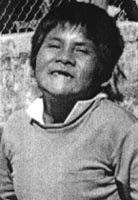
CARLOS is the son of migrant farm workers from
Oaxaca, one of the poorest states of Mexico. During harvesting season, his
family used to come north to Sinaloa (the state where PROJIMO is located)
to pick tomatoes. When he was 8 years old, Carlos already worked with his
parents in the fields. Sadly when he was 10, the boy was hit by a truck
and his brain was severely damaged. He remained mentally and physically
disabled, and also visually impaired.
Months after his accident, Carlos was taken to PROJIMO by state
social workers. While he was still in the hospital, his parents had
abandoned him. Apparently they had gone back to Oaxaca, without leaving an
address. The social workers asked if PROJIMO could provide rehabilitation
for the boy. In effect, PROJIMO became Carlos' new family.
On arrival, Carlos already had secondary physical and emotional
problems. His spastic body had become very stiff, and he had contractures
of his hips and knees. He was almost totally blind, and his mind did not
function well. He had very little short-term memory and difficulty
learning even simple things. The few words he spoke were mostly abusive
swear words. He got angry easily, and often cursed and spit at persons
trying to help him. He would repeatedly plead "I want water!" or "I want
food!" even when he had just had plenty to eat and drink. He constantly
wet and pooped his clothing and bed.
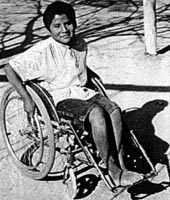
Carlitos (as he was affectionately called) needed a lot of personal
assistance, plus a huge amount of understanding and patience. Fortunately,
an older woman named Rosa, who has worked at PROJIMO for years, became
like a mother to him. Rosa lovingly bathed him and washed his soiled
clothes 2 or 3 times a day.
Mobility. To help Carlitos move himself about, one of
the first things the shop-workers did was to build a wheelchair adapted to
his size and needs. At first he could not move his wheelchair at all. But,
little by little, he learned to roll it about. In time, he could more or
less find his way on the pathways between buildings.

Water Play as Therapy. In preparation for standing and
walking, the team helped Carlitos with range-of-motion and stretching
exercises. These helped to correct contractures and reduce the spasticity
of his hips and knees. At first, he angrily resisted the exercises. But
when the team tried working - and playing - with him in water, he loved
it. The water supported his weight and let him move without the fear of
falling. His pleasure and activity in the water seemed to help his stiff
body to loosen up.
|
| 208
|
| Standing. Although
Carlitos' knees still bent stiffly when he tried to stand, the team felt
he had the potential for learning how to stand and walk. At first he was
non-cooperative, and understandably so. After nearly a year without
weight-bearing, standing hurt his feet. But with daily practice his feet
toughened. The team found that the best way to get Carlos to try to
stand was to put him with another child who was learning to stand.
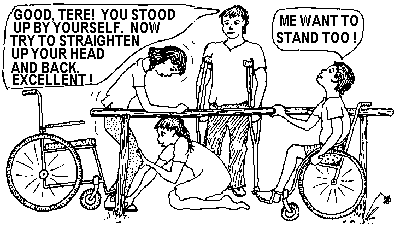
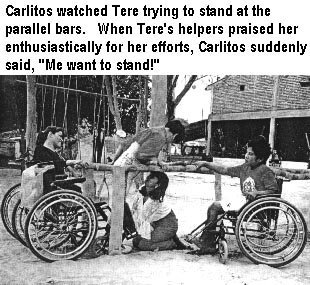
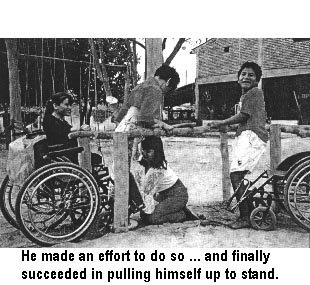
|
| 209
|
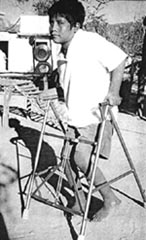 Walking.
When Carlitos first tried to stand at the parallel bars he had very poor
balance. He practiced daily. Little by little, his balance improved
until he could take a few steps, holding onto the bars. Walking.
When Carlitos first tried to stand at the parallel bars he had very poor
balance. He practiced daily. Little by little, his balance improved
until he could take a few steps, holding onto the bars. After months
of practice, he learned to walk back and forth between the bars with
fair stability. When Carlos began to say "I want walker!" the team asked
Jaime to design a walker that would meet the boy's needs.
Mari and Inez tested him with walkers of different sizes and heights.
At last they found a combination of features that allowed him to stand
straighter and more firmly. Jaime, a paraplegic wheelchair builder who
works lying on a gurney (wheeled cot), built the walker out of steel
tubing. He used thin-wall electric conduit tubing, the same material
used to make the wheelchairs.
|
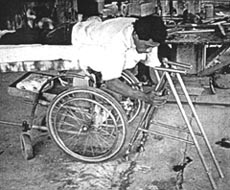
To make the folding mechanism, Jaime used the same recent
innovation that the shop workers use on an improved design of the
Whirlwind wheelchair (see p.190). |
 |
|
| 210
|
A Wooden Walker with a Seat
Carlitos enjoyed walking with his new metal walker. But his attention
span was brief and he tired quickly. After a few minutes, he would want
to sit in his wheelchair. And a few minutes later, he would want to walk
again. Because he was blind and had difficulty remembering, it was hard
for him to find things. All day long he would call out to people to
bring him his walker or his wheelchair. When everyone was busy there was
sometimes a delay, and he would get angry and frustrated. "Carlos want
walk NOW!" he would wail.
One day, Juán, a disabled carpenter and brace-maker, asked Carlos, "Carlitos,
would you like a walker with a seat on it, so that you can sit down and
rest when you're tired of walking?"
"Yes" said Carlos eagerly. "Carlos want walker with seat." So Juán
made him a unique wooden walker with a seat.

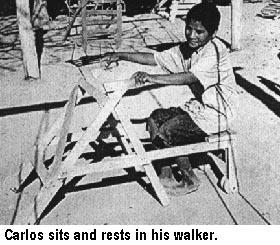
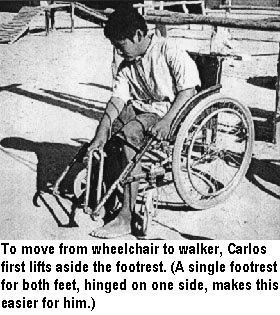

Although transferring from his wheelchair to the wooden walker
required stepping over the wooden bar that supported the seat, Carlos
soon learned to transfer without help.
With his new walker, Carlos became more independent. He no longer
needed to always ask people for help, and he began to take pride in
doing things for himself. His self-help skills in walking helped prepare
him for a better response to toilet training (see p.212). |
| 211
|
| A "Seeing-Eye Person" for Carlos.
With his walkers, Carlos' walking improved. But being blind, he had a
hard time finding his way. Someone suggested a seeing-eye dog. But it
was easier to provide a "seeing-eye person."

At PROJIMO there are always young wheelchair users who have trouble
moving about by themselves. These include Tere and Lupita, who have
spastic arms and legs. One day, Tere was practicing standing at the
parallel bars. At the same time, Carlos was walking in circles around
the outside of the bars, holding on with only one hand. To do this,
Carlos had to circle around Tere's wheelchair. Once when he took hold of
the handles of her wheelchair, he laughed and tried to push it, like a
walker. That gave Rosa an idea.
A Wheelchair as a Walker. When Tere finished her
standing session at the bars, she said she wanted to go to the laundry
area to wash her clothes. Because she has difficulty moving her
wheelchair on the uneven ground, she asked Rosa to push her.
Half-joking, she said, "Carlitos, why don't you push Tere to the laundry
area?"

Carlos grinned with excitement. "Yes! Carlitos want push Teresita!"
At first Tere was reluctant. Although she and Carlos were friends,
she feared he would wheel her into a pit or tree. But Rosa explained to
Tere that, by letting Carlos push her, she would be helping him with his
therapy, his independence, and his self-esteem. So Tere agreed to give
it a try.
Rosa guided Carlos' hands to the handles of Tere's wheelchair. Carlos
pushed it eagerly. To keep on course, Tere told the blind boy where to
go. At first he was confused. But after a while he learned to tell
"Left!" from "Right!" and steer accordingly. Carlos had never seemed so
happy, nor Tere more scared.

Carlos as a wheelchair-rider's attendant.
By that afternoon, Carlitos proudly also began to help Lupita move
from one area of the playground to the other. He was walking more and
better than he had ever walked before. And he was able to find his way,
thanks to his "seeing eye persons." This mutual self-help by persons
with different disabilities helped to build self-confidence in all who
were involved, Carlos took great pride in his new role as a "wheelchair
attendant."
Peer therapy. Tere, likewise, took pleasure in
knowing that she was helping Carlos both develop his walking skills and
gain a sense of being useful and appreciated. Lupita, whose mental
handicap is as great as that of Carlos, was all smiles with the
enthusiastic services of her newly found driver. In this way, multiply
disabled young people have learned to help one another. |
| 212
|
Toilet Training as Preparation for Standing, Balance, and Manual
Skills
Carlos' toilet training advanced slowly, with modest gains. At first,
he always pooped in his cot at night. Then he began occasionally to
crawl off his cot and poop on the floor. To reinforce this response and
take it further, Juán - with the help of two village school children -
made a simple wooden toilet seat that could be placed over a bucket next
to Carlos' cot.
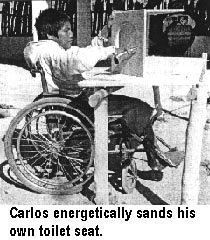
To involve Carlos more with making his toilet, the
group asked him if he wanted to help sand the wooden seat. Carlos,
always eager to "work," responded, "Yes, Carlos want sand toilet."
Perhaps because he had already tried sitting on the toilet and
identified it as his, he did the sanding with more energy and
persistence than usual.
The next step was practice using his toilet. This
involved sitting on the edge of the bed, standing up (while holding a
metal bed frame turned on its side at the head of the bed), unbuttoning
and loosening his pants, lowering his pants enough to avoid soiling them
(while leaning against the bed frame), and sitting on the toilet. After
using the toilet, he learned to repeat the same steps in reverse.
Steps in Carlos' toileting practice:

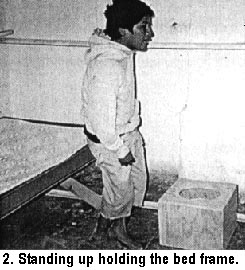
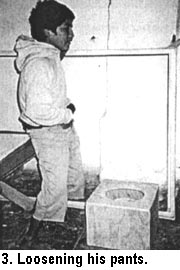
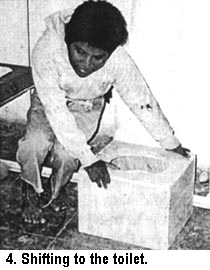
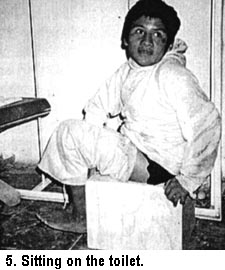
Carlitos still has a long way to go until he has no accidents in his
bed. But his bedside potty not only helps him with toilet training, it
also helps with standing, balance, dressing and undressing skills, body
coordination, and manual dexterity. He is eager to learn new skills, and
takes pride in having helped make the toilet he is learning to use. |
| 213
|
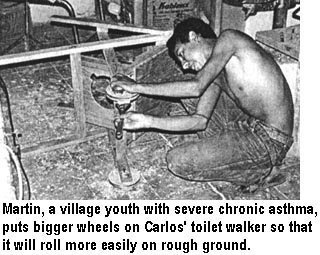
A WALKING TOILET FOR CARLOS
Problem. Carlos' new
walker-with-a-seat (described on page 210)
allowed him to sit down when and where he wanted. But the design had one
big problem. Because the seat was mounted behind the space where he
stood to push the walker, the whole device was over a meter long. This
made moving in close quarters very cumbersome. If Carlos was to learn to
walk to the dining room, he needed a walker that was more compact.
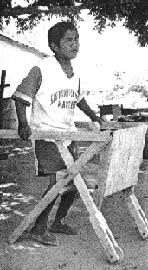 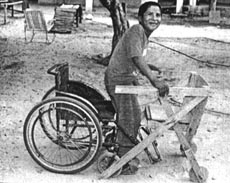 To
solve this problem, PROJIMO designed a compact walker with the
seat in front of him, not behind. Although he had to turn around to sit
down, this walker had the advantage that it had no poles to step
over. To
solve this problem, PROJIMO designed a compact walker with the
seat in front of him, not behind. Although he had to turn around to sit
down, this walker had the advantage that it had no poles to step
over.
Also, it simplified transfers from the wheelchair. Carlos
could wheel his wheelchair between the rear legs of the walker, take
hold of the walker's handle-bars and easily stand up.
Adaptation for urinating. One complication to having
the seat of his walker in front of him was hygiene. Now that Carlos was
partly toilet-trained, to urinate he would simply stand up and lower his
pants. With his old walker (with the seat behind) that was all right.
But to avoid wetting the forward-positioned seat of the new walker, the
seat needed to be hinged so that Carlos could lift it out of the way
before urinating.
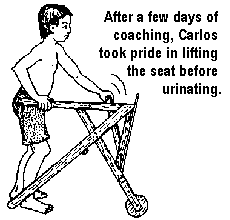
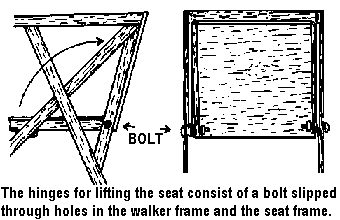
|
| 214
|
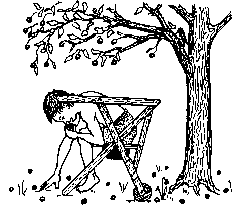
Adding a potty. The idea to adapt the walker as a
portable toilet came from necessity. It was springtime. The plum trees
at PROJIMO hung heavy with fruit. The ripest plums fell to the ground.
Carlos would park his walker in the shade of the trees, sit on the seat,
and lean over to feel with his hands for the fallen fruit. In a short
time, he would stuff his belly to bursting.
But this feast had a nasty side effect: diarrhea. Because
Carlitos was blind and forgetful, he had not learned to take himself to
the outhouse. Sometimes, when he had to go in a hurry, he called someone
to take him. And sometimes he would poop in his pants. Rosa, who had to
bath him and wash his clothes, was at her wits end.
To solve this problem, Polo helped to convert Carlos' walker into
a mobile toilet. He cut a hole in the seat to hold a
plastic bowl. Supported by its rim, the bowl could be lifted out to
empty it. To use as an ordinary seat, a square board, hinged at the
back, could be lowered over the bowl. To urinate, Carlos could swing the
whole toilet up out of the way.
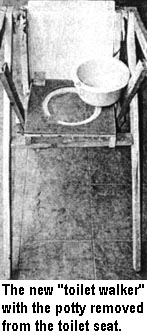
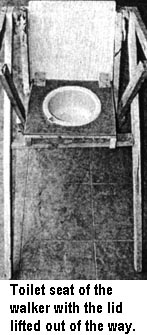
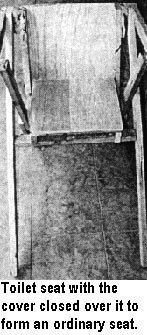

The invention saved the day. From one day to the next, Carlos became
more independent in his toileting. The stimulation caused by his
high-plum diet gave him plenty of practice, and he quickly learned to
lift the lid and lower his pants.
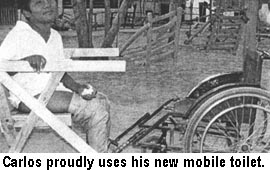 What
he never learned to do was to empty his potty. We all learned - the hard
way - about the need to empty Carlos' potty often enough, especially
during plum season. What
he never learned to do was to empty his potty. We all learned - the hard
way - about the need to empty Carlos' potty often enough, especially
during plum season.
One day, when he had filled his potty to the brim, he lost his
bearings and fell over with his walker. He and the walker were covered
with the potty's rank contents. Cecilia and the author helped with the
clean up. It was no fun!
But, despite the occasional mishaps, Carlos loved his new walker. It
not only gave him new freedom to move about, but helped him become more
fully self-sufficient with his toilet. |
| 215
|
Improvement
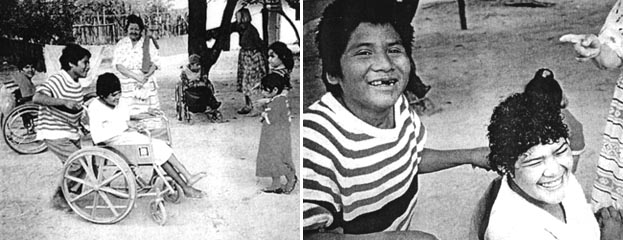
Bit by bit, in the 3 years that Carlos has been at PROJIMO, both his
physical and mental abilities have improved. He has remembered songs
from early childhood, and has learned new ones. He now talks more
cleverly, remembers people's names, gets angry less often, and laughs
gladly in response to friendliness or assistance. His common phrases now
include "I want to walk" and "I want to work." He takes pride in using
his toilet, and in staying dry and clean (sometimes).
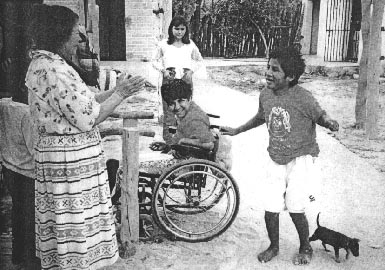
His attention span is still brief, but for several moments at a time,
he helps with activities in the toy shop. All in all - through a team
effort in which disabled persons help each other - Carlos has come a
long way.
Most important of all, Carlos has made friends and learned how to
enjoy life and people.
In addition to better balance, he now has more self-confidence in his
abilities. It was a day for celebration when, at last, Carlos
began to stand without any support or assistance. |
|